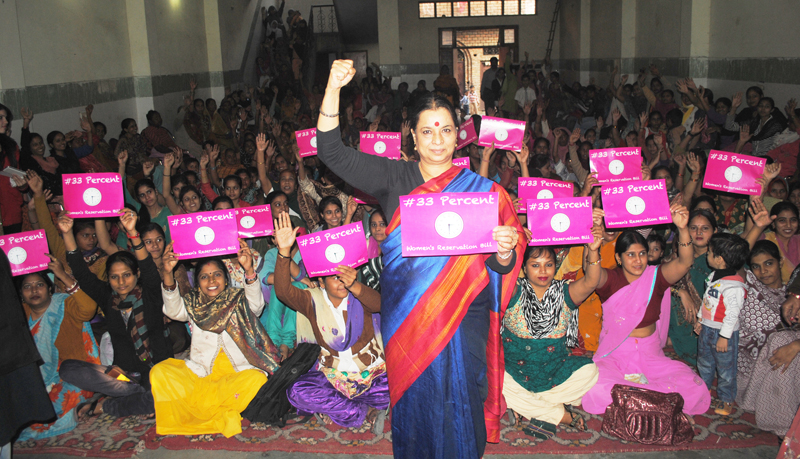The Women Reservation Bill is the story of a long awaited, drawn-out bill and cause- a story of pettiness, sexism, battles, loss and gain. Since 1996 when the bill was first introduced, much has happened. Let’s take a minute to brush over the big lines of the bill, and see where we are now with the upcoming Bihar Elections of 2015.


The objective of the Women’s Reservation Bill is to expand and scale up the reservation policy that exists at the local level (panchayats) to the lower chambers of each state and to the Lok Sabha, which is the lower chamber of the national Parliament. There is even talk today of raising the 33% reservation policy in the panchayats to 50%. The principle for the parliament remains the same: out of all the seats available, one third would be reserved for women. The reserved seats would be, here again, allocated randomly and on a rotating basis from term to term. In order for the reservation to benefit women from all caste and social backgrounds, and not only rich, educated and high-caste women, the quota of one third of the seats reserved for women would act as a sub quota in each category of seats. Therefore, one third of the seats reserved for Scheduled Castes will be reserved for women from Scheduled Castes, etc. Finally, a provision of the bill stipulates that these quotas would expire after fifteen years.
Quota systems to boost equal political representation have been used around the world. They have also been greatly contested around the world, and India is no exception. However, well-designed and implemented quotas work. 40 countries have implemented such policy at the national level. Of the 59 elections held last year, 17 had quotas. As the results of such policies are concerned, the countries with quotas policies have women occupying 27% of seats in average compared with only 16% in those without.
In 2013, Pakistan, who also faced much controversy on the subject, was one of the 40 countries to implement a reservation system for women at all levels of government- in the senate, the national assembly and subnational level. The Pakistani system does not impose parity but ensures a minimum of 17% of seats be reserved for women. 17 of the 100 seats in the Senate or 17 per cent will be reserved for women and in the National Assembly 60 of the 342 seats (18 per cent) distributed to the four provinces as follows. Today 20% of government representatives are women.
Women in the US still only have 20% of the seats in Congress since 1992, and at this rate it will take 500 years for women to achieve parity in the political sphere. Women are however making headlines in the upcoming presidential elections with Hillary Clinton and Elizabeth Warren taking the election by storm. But without an enforced policy of gender parity, and numbers which are lagging behind, are Clinton and Warren shaking up American politics or are they more show pieces? The question is a legitimate one.
The idea behind the Women Reservation Bill is not new, as it was first put forward in 1996. Since then, sabotage and bureaucracy have delayed its examination by the different chambers of Parliament. The 18-year-journey of the Women’s Reservation Bill was marked by high drama and roadblocks in each session of Parliament before the historic measure cleared the first legislative hurdle in March, 2010, when Rajya Sabha (upper chamber of parliament) passed it during a sitting which saw marshals being used. By roadblocks, I mean petty opponents to the bill deliberately and systematically sabotaging the passing by stealing the document to be submitted, blocking the way to representatives in favor and so on. The Bill is currently awaiting discussion and vote by the Lok Sabha.
Women’s organizations across the country emphasize that it has been 18 years since the struggle for the passage of the Bill in Rajya Sabha and endorsed by at least 15 State Assemblies took place. Therefore, Women’s Organizations are voicing their concern and disbelief that there is still a delay in introducing the Bill in the Lok Sabha. It is long overdue.
On the other hand it isn’t surprising when representatives such as Mulayam Singh Yadav explains his opposition on the Women’s Reservation Bill in 2012, by saying “Rural women will not benefit from women reservation bill. It is always the affluent women who benefit because rural women are not attractive.” Such declarations are particularly alarming when the same politician of the Samajwadi Party (prominent Bill saboteur), who is a key player in the Bihar election of 2015, continues to hold a sexist and shaming discourse three years later, notably towards his party leader Leelawati Kushwaha.
Furthermore, the Women’s Reservation Bill appears not to be on the immediate agenda of the government as it informed the Rajya Sabha on August 7th 2015 that it has not “restarted” consultation on the contentious issue with any political party or other stakeholders. Law Minister D.V. Sadananda Gowda informed the Upper House in a written reply that the “government has not restarted consultation with any political party or other stake holder” on the bill which had lapsed following the dissolution of the 15th Lok Sabha.
Mr. Gowda added that it has been the endeavor of the government to provide for reservation of one-third seats for women in Lok Sabha and state assemblies. “However, the issue involved needs careful consideration on the basis of consensus among all political parties before a bill for amendment in the Constitution is brought before Parliament,” the minister said.
The Minister of Women and Child Development herself in a written reply on September 14th 2015 said the bill is indeed important, although in need of a few modifications, but that she does ‘not see it listed for Parliament in the near future’.
Women’s organizations, human rights and civil society organizations (including the Centre for Social Research) across the country demand that the Bill be itemed in the Agenda of the Winter Session of Parliament in 2015. Although the bill isn’t perfect, and could stand for some modifications, the priority is to pass it first, and take care of modifications once passed in the Lok Sabha. Modifications could include making sure the quotas don’t disappear after 15 years, increasing the percentage of seats at each elections, and making sure the Bill is coupled with other incentivizing policies: better access to quality education for girls, safer cities, gender parity in the workforce and in salary…etc.
In the meantime in the 2015 Bihar elections Yadav continues to spew sexist comments, alongside others such as Nitish Kumar and Modi, who are slowly recognizing the political force women are becoming, and are responding by devising strategies to harness their growing power. Although some thought is being put into capturing women’s votes in the Bihar election, little to nothing is said on the Women Reservation Bill and equal political representation.
Written by Nikita Blanes
Donation for Centre for Social Research to Join our effort in rehabilitating Domestic Violence
Discuss this article on Facebook




